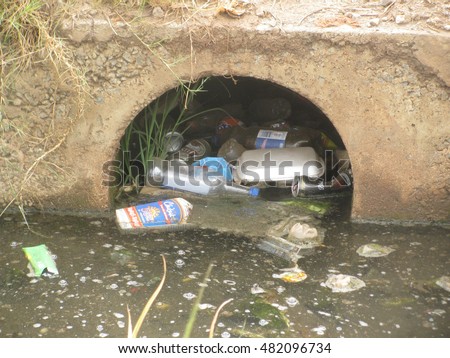What's the problem
Blocked storm drain in Harare
Litter isn't what it used to be
Archaeologists make a good part of their living from studying ancient litter; the broken pots, discarded stone tools, bones and shells, lost copper bracelets and rusted old knives of the ancient world. It's only on rare occasions that organic material, such as wooden foundations and bits of old boats, will survive (e.g. at Star Carr, the earliest known site of habitation in the UK, and just a couple of miles south from where I sit, wooden objects have survived 9000 years by being buried in peat). The invention of plastics will make it much easier for the archaeologists of the future to find out about us.
Reducing the amount of litter generated.
One way to reduce litter is to cut off the supply. A few years ago it was possible to identify the nearest supermarket by the colour of the discarded plastic bags. Orange for Sainsbury's, blue and white for Tesco's, yellow and black for Morrison's. Since we've had to pay for them demand has dropped by 85%. Many countries have deposit schemes on plastic bottles and aluminium cans so that even if the original user doesn't take them back there's a good chance that someone else will.
First step = municipal waste collection
Changing behaviour
Persuading people not to drop litter in the first place is more difficult. We're more responsive to what the people around us actually do than any official message. In the obscurely titled blog post "The exception proves the rule" I looked at one of the few studies of littering behaviour I could find. The simple conclusion of this study was that litter breeds litter. Unless you actually get rid of most of the existing litter it's very hard to stop people simply dropping more.
First big clean up
Once you've got an area cleaned up, which might involve paying local people to help do it, the challenge then is to keep it clean. Eating food on the street is now an established habit across the world and is unlikely to end. So unless there are convenient bins for people to put their litter in, which are emptied before they start overflowing, the problem will simply recur.
Litter bins
When we were addressing the problem on the old railway line in Scarborough (which is now a quiet route for walkers and cyclists) we made sure that there was a bin at every point of access. Not only did this reduce the amount of litter left on the track but it also meant that casual litter pickers, such as myself, had somewhere convenient to put the litter that we'd picked. We've been surprised how many fellow citizens now respond to the sight of someone else's litter by picking it up and putting it in the bin. An additional advantage of keeping the track relatively clean is that it feels like a safer, looked after, space and more vulnerable people are happier to use it.
Community participation
But every now and then, particularly in winter when the vegetation dies back and hidden litter is revealed, we do have to have an organised litter pick and to do this you need to have active citizens who are prepared to join in. And this, in turn, needs people to have a sense of ownership of the public space.
Other cultural norms are possible
Changing cultural attitudes to litter is difficult but not impossible. Most of us live within the social norms that are set by the people around us and these are different all over the world. We like going on holiday to the Dalmation coast of Croatia. One of the things we like about it is that there is a walking culture. In the evenings it's the habit for everyone to go out and promenade, the paths and footways are all maintained and there's very little litter. Having spoken to Croats about this the response was simple "it's just not something we do". They either put it in a bin or take it home. Indeed, when we spent a week last year wandering around the island of Mljet I saw only one piece of litter and couldn't help taking a picture.
The only piece of litter we saw on Mljet (august 2016)
Just so you don't think I spent all my time staring at the ground......
Looking down on the the salt water lakes of Mljet
A couple of links
Here's a proposal for a study in Cape Town. which suggests using litter traps on storm drains and then correlating the amount trapped this with different strategies used to reduce litter in different catchments. I was not able to find out if this work actually took placeA summary of Behavioural interventions that might be taken to reduce littering in the UK



No comments:
Post a Comment